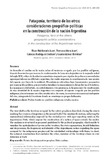| dc.rights.license | http://creativecommons.org/licenses/by-nc-sa/3.0/ve/ | |
| dc.contributor.author | Rivas Maldonado, Juan | |
| dc.contributor.author | Troncoso Mora, Juan | |
| dc.contributor.author | Cabezas Rodríguez, Emilson | |
| dc.contributor.author | Loyola Gómez, Christian | |
| dc.date.accessioned | 2015-12-03T16:14:10Z | |
| dc.date.available | 2015-12-03T16:14:10Z | |
| dc.date.issued | 2015-07 | |
| dc.identifier.issn | 1012-1617 | |
| dc.identifier.uri | http://www.saber.ula.ve/handle/123456789/41322 | |
| dc.description.abstract | Se describe el cambio en la visión sobre el territorio ocupado por los pueblos indígenas, durante los eventos que marcan la conformación de la nación Argentina en la segunda mitad del siglo XIX, reflejo de la relación asimétrica impuesta por cúpulas de poder con necesidades agroexportadoras en el Estado argentino, las cuales imponen la construcción de una noción del espacio por fuera de la realidad. El análisis se estructura bajo lineamientos propuestos por la geografía política, que permiten visualizar la espacialización del poder en el territorio, la organización del estado, su autodefinición y su presencia, la hegemonía y la construcción de una identidad de la nación Argentina con respecto al espacio ocupado por los pueblos indígenas y las relaciones con ellos establecidas. En suma, la construcción nacional excluyente del otro, integrante del territorio donde se construye su propia definición. | es_VE |
| dc.language.iso | es | es_VE |
| dc.rights | info:eu-repo/semantics/openAccess | |
| dc.subject | Poder | es_VE |
| dc.subject | Territorio | es_VE |
| dc.subject | Pueblos indígenas | es_VE |
| dc.subject | Estado | es_VE |
| dc.subject | Nación | es_VE |
| dc.title | Patagonia, territorio de los otros: consideraciones geográfico-políticas en la construcción de la nación Argentina | es_VE |
| dc.title.alternative | Patagonia, land of the others: geographic-politics considerations in the construction of the Argentinean nation | es_VE |
| dc.type | info:eu-repo/semantics/article | |
| dc.description.abstract1 | The view shift on the territory occupied by the native peoples is described, during the events marking the creation of Argentina in the second half of the nineteenth century, reflecting the asymmetrical relationship imposed by the central power with agro-exporting needs in the Argentinean State, which impose the construction of a notion of space outside the reality. The analysis is structured as proposed guidelines by the political geography, which enable to visualize the spatialization of power in the territory, the state organization, its self-definition and its presence, the hegemony and identity of the Argentinean nation regarding the space occupied by the indigenous peoples and the established relationships with them. In short, the national construction that excludes the other, member of the territory where its own definition is built. | es_VE |
| dc.description.colacion | 269-290 | es_VE |
| dc.description.email | jrivas@ubiobio.cl | es_VE |
| dc.description.email | jptroncoso@ubiobio.cl | es_VE |
| dc.description.email | emcabeza@egresados.ubiobio.cl | es_VE |
| dc.description.email | cloyola@ubiobio.cl | es_VE |
| dc.description.frecuencia | semestral | |
| dc.identifier.depositolegal | 195902ME658 | |
| dc.publisher.pais | Venezuela | es_VE |
| dc.subject.facultad | Facultad de Ciencias Forestales y Ambientales | es_VE |
| dc.subject.institutoinvestigacion | Instituto de Geografía y Conservación de los Recursos Naturales (IGCRN) | |
| dc.subject.keywords | Power | es_VE |
| dc.subject.keywords | Territory | es_VE |
| dc.subject.keywords | Native peoples | es_VE |
| dc.subject.keywords | State | es_VE |
| dc.subject.keywords | Nation | es_VE |
| dc.subject.publicacionelectronica | Revista Geográfica Venezolana | |
| dc.subject.seccion | Revista Geográfica Venezolana: Artículos | es_VE |
| dc.subject.thematiccategory | Geografía | es_VE |
| dc.subject.tipo | Revistas | es_VE |
| dc.type.media | Texto | es_VE |


